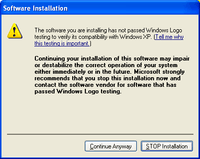WHQL Testing
Windows Hardware Quality Labs testing or WHQL Testing is Microsoft's testing process which involves running a series of tests on third-party hardware or software, and then submitting the log files from these tests to Microsoft for review. The procedure may also include Microsoft running their own tests on a wide range of equipment, such as different hardware and different Microsoft Windows editions.
Overview



Products that pass the WHQL tests get to use a "Certified for Windows" logotype, which certifies that the Hardware or software has had some share of testing by Microsoft to ensure compatibility. The actual logo used depends on the version of Microsoft Windows.
For device drivers passing the WHQL tests, Microsoft creates a digitally signed certification file that, when included in the driver installation package allows installation on 64-bit versions of Windows and prevents 32-bit versions of Windows Vista and all versions of Windows XP from displaying a warning message that the driver has not been certified by Microsoft (see Windows XP screenshot on the right).
New since June 2007 is the requirement of an Audio Fidelity Test equipment (Audio Precision SYS-2722-A-M) for System Submissions.[1]
A company can choose to sign their own drivers rather than go through the WHQL testing process. These drivers would not qualify for the "Certified for Windows" logos, but they would install on 64-bit versions of Windows and install without a warning message on 32-bit versions of Windows Vista or Windows 7.[2] However, it will not install without a warning message on Windows XP.[3]
Some device drivers that have passed the WHQL tests are also made available for download using Windows Update or the Microsoft Update Catalog.
When Windows XP detects a new device for which it does not have built-in drivers, it will show a Found New Hardware Wizard (see screenshot on the right). One way to avoid the Found New Hardware Wizard from popping up on Windows XP is by pre-installing a WHQL certified driver before the device is plugged in.
Microsoft no longer requires a WHQL testing fee,[4] which used to be USD $250 per operating system family.[5] This fee covers both 32-bit (x86) and 64-bit (x64) versions, if submitted simultaneously, and is non-refundable. The fee does not include other expenses, such as a Windows Server 2008 x64 license, necessary for running WHQL tests, and a VeriSign certificate, necessary for submitting test results.[6]
Sometimes there is ambiguity over who is responsible for providing drivers, and who they are supported by. This is the case for industry standard devices which are used much more broadly than the PC platform, but for which Microsoft does not supply the drivers. For example, there are no WHQL Bluetooth (stereo) headsets.
See also
- Windows Hardware Lab Kit (WHLK)
- Windows Hardware Certification Kit (WHCK)
- Windows Logo Kit (WLK)
References
- ↑ "Windows Vista Logo Program - Audio Fidelity Testing Policy Update". Windows Hardware Developer Central website. Microsoft Corporation. 18 June 2008. Retrieved 7 February 2011.
- ↑ "Digital Signatures for Kernel Modules on Systems Running Windows Vista". Windows Hardware Developer Central website. Microsoft Corporation. July 27, 2007. Retrieved 2008-07-30.
- ↑ Roberts, Tim (April 8, 2009). "Re: Digital sign a driver for XP and Vista". tech-archive.net. Retrieved 7 February 2011.
- ↑ "Hardware Certification Policies and Processes" (DOC). Microsoft Corporation. 7 January 2014. Retrieved 24 June 2015.
- ↑ Bethel, Lyndon (21 August 2006). "DTM Global WHQL Policies Draft" (DOC). Microsoft Corporation: 28. Retrieved 7 February 2011.
- ↑ "Windows Logo Kit 1.6 Step by Step Guide". Microsoft Corporation. 13 September 2011. Retrieved 22 November 2011.